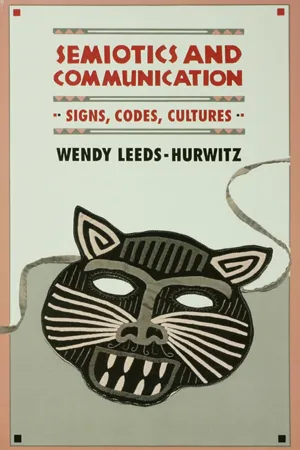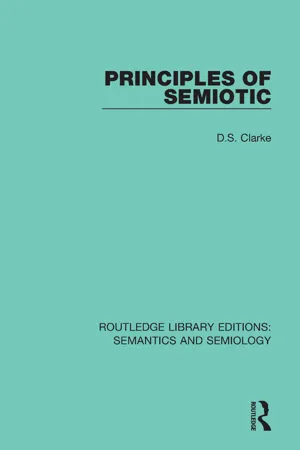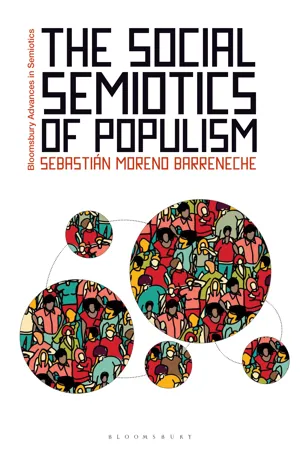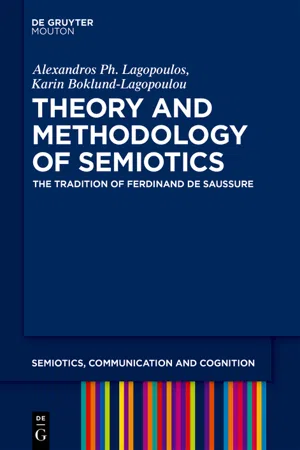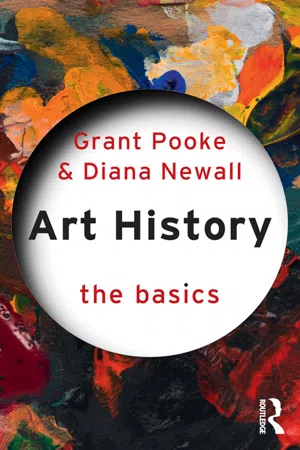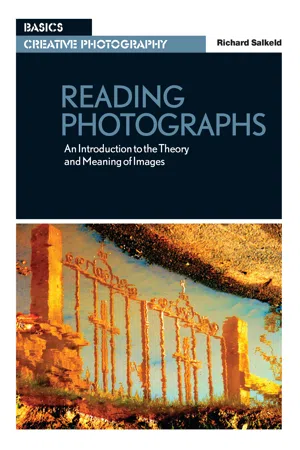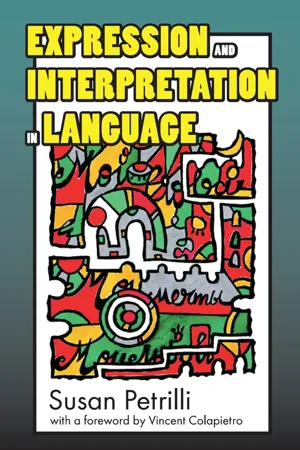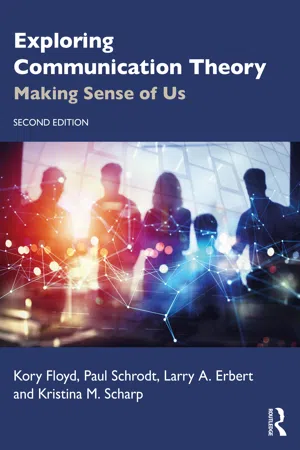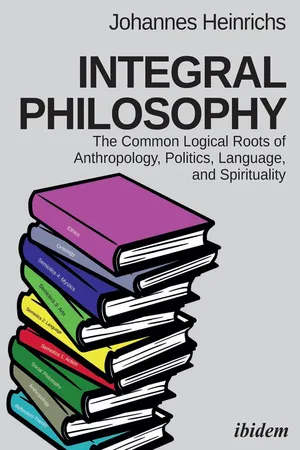Languages & Linguistics
Semiotics
Semiotics is the study of signs and symbols and their interpretation. It explores how meaning is created and communicated through various systems of representation, such as language, images, and gestures. Semiotics examines the relationship between signifiers (the form of the sign) and signifieds (the concept or meaning associated with the sign), providing insights into communication and cultural expression.
Written by Perlego with AI-assistance
Related key terms
Related key terms
1 of 4
Related key terms
1 of 3
11 Key excerpts on "Semiotics"
- eBook - ePub
Semiotics and Communication
Signs, Codes, Cultures
- Wendy Leeds-Hurwitz(Author)
- 1993(Publication Date)
- Routledge(Publisher)
298). 20 She proposed that the other human sciences can learn from the model provided by linguistics by treating other aspects of human behavior as languages and put forth Semiotics as the umbrella term for the set of human sciences because they all study meaning and sign systems. In addition to the reasons that linguistics serves as the key to understanding human behavior for a variety of fields, it remains central to semiotic theory due to the added historical connection, via Saussure and his followers. 21 Culture, Communication, Semiotics Two concepts essential to an understanding of Semiotics are culture and communication. Definitions of both abound because they are central to the understanding and study of human behavior. The subject matter of Semiotics is often described as being communication, as evident in some of the quotations supplied previously. Thomas Sebeok, the dean of Semiotics in the United States, made this absolutely explicit: The subject matter of Semiotics, it is often credited, is the exchange of any messages whatsoever, in a word, communication. To this must at once be added that Semiotics is also focally concerned with the study of signification. Semiotics is therefore classifiable as that pivotal branch of an integrated science of communication to which its character as a methodical inquiry into the nature and constitution of codes provides an indispensable counterpoint. (Sebeok, 1986a, p - eBook - ePub
- David S. Clarke(Author)
- 2016(Publication Date)
- Routledge(Publisher)
After Peirce the study of signs took two very different directions, with the divisions marked largely along geographic lines. In Continental Europe the science of signs became known as ‘semiology’ and came to have an anthropocentric orientation. In the United States the key terms of semiotic were defined relative to the concepts of the emerging science of comparative animal psychology. The initial formulation of the program of semiology was provided by Ferdinand de Saussure. Semiology is to have as its subject matter, Saussure says, all the devices used in human society for the purposes of communication, including both linguistic expressions and non-linguistic devices such as gestures and signals within non-linguistic codes. Semiology in this conception is an empirical science, with linguistics a sub-division dealing with language as a special means of human communication:Language is a system of signs that express ideas, and is therefore comparable to a system of writing, the alphabet of deaf-mutes, symbolic rites, polite formulas, military signals, etc. But it is the most important of all these systems.A science that studies the life of signs within society is conceivable; it would be a part of social psychology and consequently of general psychology; I shall call it semiology (from the Greek semeion ‘sign’). Semiology would show what constitutes signs, what laws govern them… . Linguistics is only a part of the general science of semiology; the laws discovered by semiology will be applicable to linguistics, and the latter will circumscribe a well-defined area within the mass of anthropological facts.42Excluded by Saussure from semiology are the traditional natural signs and Peirce’s indices, as well as signs used for communication by lower organisms. In another departure from Peirce’s semiotic as a ‘quasi-necessary’ science studying features that must obtain of signs used by interpreters ‘capable of learning by experience,’ semiology restricts itself to features that in fact obtain of devices used in human communication. Logical analysis is thus abandoned in favor of empirical description characteristic of such sciences as sociology and anthropology. - eBook - ePub
- Sebastián Moreno Barreneche(Author)
- 2023(Publication Date)
- Bloomsbury Academic(Publisher)
Semiotics as one to refer to almost everything that is related to signs, signification, meaning, language and discourse.However, a second sense of the noun Semiotics refers to a specific science, discipline, research field or outlook – discussions on the epistemological status of Semiotics are still ongoing – within the social and human sciences. This discipline has its origins in the late nineteenth century, took the form of a relatively autonomous discipline in the 1960s and made of Semiotics its object of study. Semiotics – spelled with an initial capital S – can be hence defined as the social science that studies the Semiotics of a broad spectrum of phenomena. In this sense, the title of this book could also be read as The social S emiotics of populism given that its content employs the concepts, methods and tools that have been developed during the twentieth century within Semiotics by scholars and researchers that identify themselves as semioticians.3In his introduction to Semiotics, Daniel Chandler (2017 : 2) writes that semioticians ‘study how meanings are made and how reality is represented (and indeed constructed) through signs and sign systems’. Although this statement encompasses in a simple and clear manner what semioticians do, it does not set clear boundaries between their activity and that of discourse analysts, linguists with an interest in pragmatics and discourse, cultural anthropologists or other social scientists. As Eco (1976 : 5) argues, there are ‘many disciplines other than Semiotics’ that have ‘already undertaken [. . .] research on subjects that a semiotician cannot but recognize as his own concern’. Chandler (2017 : 3) also states bluntly that Semiotics ‘is still not widely institutionalized as an academic discipline’. This lack of institutionalization is the result of how the discipline was born and evolved during the twentieth century.4 - eBook - ePub
Theory and Methodology of Semiotics
The Tradition of Ferdinand de Saussure
- Alexandros Ph. Lagopoulos, Karin Boklund-Lagopoulou(Authors)
- 2020(Publication Date)
- De Gruyter Mouton(Publisher)
Part I: The field of SemioticsChapter 1 Introduction: What is Semiotics?
Semiotics studies the processes of semiosis. This means that it studies meaning, and the specific perspective that defines and constitutes its domain is meaning – sens in French – but more strictly, in both languages, signification. All cultural systems – language, literature, art, cinema, music, architecture, dress, etc. – are vehicles of signification. But such phenomena are virtually omnipresent. Is it possible to bring all these separate phenomena under one and the same umbrella? And what is the relation of Semiotics to sociology, social or cultural anthropology, philosophy or psychology?All semiotic systems have a material vehicle, though this vehicle may be more or less obvious. Oral speech seems to be immaterial, but linguists know that its sounds are carried by sound waves. Literature seems to consist only of meaning, but it too needs a material vehicle, whether in the form of paper and ink or marks on a computer screen (or even traces carved in stone). Painting needs a canvas and colours. In all these cases, the material seems insignificant in comparison to the meaning, though it is always present. But in other cases, the material vehicle overshadows the meaning. An automobile, for example, is constructed with metal and a building with concrete and bricks or steel and glass, and these objects as such are not made by meaning, but they can still be vehicles of meaning.The difference between the semiotic and the non-semiotic or extra-semiotic aspects of cultural objects and phenomena is clarified by Umberto Eco. He writes that it is possible to study all social phenomena “sub specie communicationis”, that is, from the viewpoint of Semiotics, which is why he considers Semiotics as a “general theory of culture” (Eco [1968] 1972: 28, 1976 : 26–27). However, he adds that social phenomena cannot be reduced - eBook - ePub
Language and Materialism
Developments in Semiology and the Theory of the Subject
- Rosalind Coward, John Ellis(Authors)
- 2016(Publication Date)
- Routledge(Publisher)
3 Semiology as a science of signsSaussure foresaw a 'semiology' of which linguistics would be at once one part and the privileged methodological guide. It was this 'science of the life of signs within society' that saw a rapid growth in France in the 1950s and 1960s, and it was the developments from this basis that led to the critique of the notion of the sign and of the structuralist method outlined in the last chapter.Semiology aims to take in any system of signs, whatever their substance and limits; images, gestures, musical sounds, objects, and the complex associations of all of these, which form the content of ritual, convention or public entertainment: these constitute, if not languages, at least systems of signification (Barthes, Elements of Semiology , p. 9).Food and clothes, for instance, carry meanings which organise their usage: there are conventions of eating and clothing, as well as meanings attached to both individual items and combinations of food and apparel. 'Confronted with the "limitless text" of fashion, food, furniture, urban design, all the day-to-day phenomena of life, the semiologist tries to understand the diverse processes of signification by the elaboration of models fitted to realise the system of intelligibility of each object' (S. Heath, Vertige du déplacement, p. 62). Semiology was thus an extension of the methods of Saussurean linguistics into new territories.At first, the tools furnished by linguistics – the conception of signifies and signifieds caught in a system of difference which provides the very possibility of their being understood – were applied to the systems of, for example, playing cards, traffic lights and menus, as though these were independent of language. It became increasingly evident, however, that they depend crucially upon language for their intelligibility, not only as a relay of their meaning, but, vitally, to found their very system of difference. This necessitated a revision of the basis of the work, a concentration on the study of language itself. Equally, semiology was originally based on what Barthes was able to call, in 1971, 'a euphoric dream of scientificity' (Tel Quel, - eBook - ePub
- Anne D'Alleva, Michael Cothren(Authors)
- 2021(Publication Date)
- Laurence King Publishing(Publisher)
how the artist, viewer, and culture at large go about creating those meanings.The founding semioticians: Saussure and PeirceAlthough the theory of signs has existed in different forms since ancient times, the modern theory of signs is based fundamentally on the work of two theoreticians: the Swiss linguist Ferdinand de Saussure (1857–1913) and the American philosopher Charles Sanders Peirce (1839–1914). According to Saussure, the sign is composed of two parts (Figure 2.1 ):Signifier the form that the sign takes Signified the concept it represents 2.1 Diagram of a Saussurean sign.The relationship between the signifier and the signified is the process of “signification,” represented by the arrows in the diagram. To go back to the example of a tree, that thing seen when looking out the window would be the “signified,” and the word t–r–e–e spelled out on the page would be the “signifier.”Charles Sanders Peirce explained the structure of signs somewhat differently. He argued that the sign is made up of three parts: Representamen the form that the sign takes (not necessarily material) Interpretant the sense made of the sign Object the thing to which the sign refersWithin Peirce’s model of the sign, a traffic light, as sign, would consist of: a red light at an intersection (the “representamen”); vehicles halting (the “object”); and the idea that a red light indicates that vehicles must stop (the “interpretant”). Peirce understood that the process of interpreting signs tends to generate even more signs: the way the driver formulates the idea - eBook - ePub
- Diana Newall, Grant Pooke, Diana Newall(Authors)
- 2008(Publication Date)
- Routledge(Publisher)
7 ).Figure 15 An Allegory with Venus and Cupid, Bronzino, c.1540–50, oil on wood, 146.5 × 116.8cm, © National Gallery, London.This chapter explores the principles of semiotic theory and considers its relevance to contemporary theories of art. It concludes with a consideration of the limitations and repercussions of poststructuralist theories.SOME BASICS ABOUT LANGUAGE AND LINGUISTICS Saussure and Peirce (pronounced ‘purse’) developed different theories for explaining the workings of linguistic signs. Saussure explored signs in relation to language.Fundamentally, language is a means of communication between human beings (and possibly animals (Sebeok 1972)) and the study of languages is called linguistics. The components of language are verbal – relating to speech, sounds or phonetics – and written – relating to the written representation of sounds and words. The academic discipline of linguistics studies the structures and relationships of these different components in order to understand the construction and origins of languages. For example, linguists might look at the structures within a written language, the structural connections between two different languages or relationships between verbal and written forms of a language. A subset of the discipline is phonetics, which studies the sound systems of languages and how individual verbal sounds (phonemes) form words.FERDINAND DE SAUSSURESaussure explored language from a perspective diferent to these approaches. He sought to explain how words in a language – linguistic signs – mean what they mean. He wanted to understand the construction of signs and their meaning rather than the structures of specific languages. - eBook - ePub
Reading Photographs
An Introduction to the Theory and Meaning of Images
- Richard Salkeld(Author)
- 2020(Publication Date)
- Routledge(Publisher)
The newspaper's advice to 'keep calm' seems ironic within the visual noise of words, signs and symbols jostling for attention. The layers of space - the 'real' space of the woman, the two-dimensional space of the image of the man, and the reflected space of the street in the window - all make for a complicated yet readable image.Semiotics: the study of signs
Semiotics (alternatively referred to as 'semiology') has its historical roots in the work of Swiss linguist Ferdinand de Saussure, whose lectures were first published in 1916, and the near contemporary, but independent work of American philosopher Charles Sanders Peirce. It was not until the 1960s and 1970s when, through the writings of Roland Barthes and others, the method began to have widespread academic application. Today, it has become a fundamental element in the critical and analytical vocabulary of visual culture, most obviously perhaps in the reading of advertisements.The method has evolved from one of 'decoding', or assuming that meanings were fixed, to one of interpretation - recognizing that meanings are actively produced through the process of reading. Meanings are made, not found.We use signs to give meaning to things; not just in the literal sense of using words and symbols to give names to things, but in the sense that everything can be given a sign value: objects, gestures, appearance and images. We ourselves function as signs and everything we do and say is understood through the interpretation of those signs. In his collection of essays, Mythologies (1993), Roland Barthes showed how familiar and commonplace aspects of culture (such as wine, Citroen cars, steak and chips, advertisements for washing powder) can be understood to encode and signify a whole range of beliefs and social relations. The following sections examine the technical language of Semiotics and the operation of the sign.Roland Barthes (1915–1980)French critic and theorist, Barthes was a key contributor to the development of Semiotics, drawing on the earlier work of Ferdinand de Saussure (1857-1913). His 1957 essays, collected in Mythologies (1993), applied the semiotic method to an engaging variety of examples of popular culture. The Semiotics of photography are examined in 'Rhetoric of the Image' and The Photographic Message', which can be found in Image-Music-Text (1977). Barthes took a more personal and meditative approach to photography in Camera Lucida - eBook - ePub
- Susan Petrilli(Author)
- 2017(Publication Date)
- Routledge(Publisher)
does not delude itself into believing that the study of signs is possible without keeping account of philosophical issues that regard its conditions of possibility.Sebeok extended the boundaries of sign studies, providing an approach to “Semiotics” that was far more comprehensive than was traditionally practiced by “semiology.” As anticipated above (section 4.1 ), the limit of sémiologie as perspected by Saussure is that it is based on the verbal paradigm and consequently is vitiated by the pars pro toto error—in other words, it mistakes the part (human signs and in particular verbal signs) for the whole (all possible signs, human and nonhuman). On the basis of this mystification, semiology wrongly claims to be the general science of signs. When, instead, the general science of signs chooses the term “Semiotics” for itself, it takes its critical distances from semiology and its errors. Sebeok dubbed the semiological tradition the “minor tradition” by contrast to the “major tradition” delineated by John Locke, Charles Peirce, and with reference to the ancients, Hippocrates and Galen, who studied symptoms (Petrilli and Ponzio, 2000b). He propounded a wide-ranging vision of Semiotics that actually converges with the study of life and its evolutionary development.On a question of terminology concerning how to best nominate the study of signs and, therefore, on the distinction between “semiotic,” “Semiotics,” “semeiotics,” and “semiology,” Sebeok offers the following clarification in his introductory note to his 1971 collection of Charles Morris’s classic works:In conformity with traditional English usage, Morris called the science of signs semiotic. This Stoic term was reintroduced, in 1690, into English philosophical discourse by John Locke, as his label for the “doctrine of signs,” a science which was greatly advanced thereafter by Charles Sanders Peirce, commencing in the late 1860s. Around 1897, Pierce used the word semiotic, in Locke’s sense, for “the quasi-necessary, or formal, doctrine of signs.” Saussure’s etymologically kindred term, sémiologie, by which he meant “une science qui étudie la vie des signes…,” was first recorded in a note of his dated November, 1894, and has also passed into English usage; to cite a single recent example, Roland Barthes’ Eléments de sémiologie (1964) was rendered by its translators as Elements of Semiology (1968). Although sometimes semiotic and semiology are interchangeable synonyms, certain authors—perhaps most notably Louis Hjelmslev—differentiated between them sharply and consistently; semiology - eBook - ePub
Exploring Communication Theory
Making Sense of Us
- Kory Floyd, Paul Schrodt, Larry A. Erbert, Kristina M. Scharp(Authors)
- 2022(Publication Date)
- Routledge(Publisher)
The sign is not the object itself, but it stands for the object. Many types of signs exist, but scholars regard three types of signs as primary. 1 The first is an icon, which is a sign that is similar to the object it represents. A photograph is an icon because it bears the image of the object it stands for. The second type is an index, which connects one object or event with another. A wedding ring is an index that represents not only the wedding ceremony but also a commitment to marriage. The third type is a symbol, which has no necessary connection to what it represents. The choice of symbols is arbitrary. The word “strawberry” is a symbol for that object—but only because we call it by that name. If we wanted, we could call a strawberry an avalanche, and if we all agree that the tasty red fruit is an avalanche, then we have created a different symbol for it. Signs are human artifacts used as tools to construct meaning. Semantics is the study of meaning and is a subfield of Semiotics, the study of signs. 2 A meaning-centered approach to communication draws attention to the use of words, symbols, and language in human experience. This approach leads us to ask questions about the nature of meaning, such as, “How is meaning possible? To what extent is meaning created at the intersection of individuals and social others? How do we know when we achieve mutual understanding?” These questions center on what is called the problematics of understanding 3 and reflect the fact that meaning-making involves a human act (an utterance or gesture), usually directed at another human (object or target), filtered through language and cultural meaning systems (an interpretive screen), with some hope of developing coordinated behaviors that might achieve common goals - eBook - ePub
Integral Philosophy
The Common Logical Roots of Anthropology, Politics, Language, and Spirituality
- Johannes Heinrichs(Author)
- 2018(Publication Date)
- Ibidem Press(Publisher)
Finally, with regard to language and action, what in the field of action were objectively distinct genera appear in language acts as their “extra” activity dimensions, as components that “represent” the language in its multidimensional sense. All this is included in the seemingly simple, yet novel, statement that language is a meta-action and meta-sign-action of a special, higher reflected kind.1. Sigmatic or sign dimension
Charles W. Morris distinguished three semiotic dimensions: syntactic, semantic, and pragmatic. He does not know a sigmatic dimension because the duties of sigmatic fall under his (too wide and vague) concept of pragmatism: as relation of the user to the signs, where these tasks were mingled with behaviorist psychology. Which tasks are now that of the sigmatic dimension4 or sign dimension?1.1 Sigmatic sigmatics: Idea and emergence of language signs
Emergence of language signs means the mere perception of a language sign as a sign. It comes to the astonished recognition that a sign is just a sign, not a random arrangement of sticks in the forest. So on the language level it is not a random body freeze, but an expression and sign gesture, not random sounds, but gesture by tongue sounds. This features the entire (vocal) speech: to be lingua gestures or standardized tongue gestures with sounds.Surely, sound or tongue gestures are not the most original form of human language, but have already a rather refined “medial” form, in the invisible medium of air and of audibility. Even from systematic considerations, “objective” picture fonts and symbol languages with moving things precede spoken language. However, these prefigurations of spoken language are lost so much in the darkness of history that the linguistic guild only says the first forms of writing in present-day Mesopotamia around 4000 BC to fix. Hereby, the font is only meant to serve the already spoken language.1.2 Semantic sigmatics: Meaning-imprinting of the material elements of language
The question is about the material language units of the lowest elements here, about phones, phonemes, syllables unto words, which are the first units of sound and independent meaning (relatively independent from circumstances). The fewest words and their roots consist of onomatopoeic syllables in the long term. Most are linked to “conventional,” so not naturally existing meaning, no longer justifiable even for the linguist. Furthermore, over speech-acts to text units, which can be fundamentally different, are limited (objective units of text, live text, dialogical texts, i.e., call contexts, finally structural textures). All these sign-units are materially and sigmatically to consider and are at the same time of meaning-importance, therefore semantic sigmatics.
Index pages curate the most relevant extracts from our library of academic textbooks. They’ve been created using an in-house natural language model (NLM), each adding context and meaning to key research topics.
Explore more topic indexes
Explore more topic indexes
1 of 6
Explore more topic indexes
1 of 4
